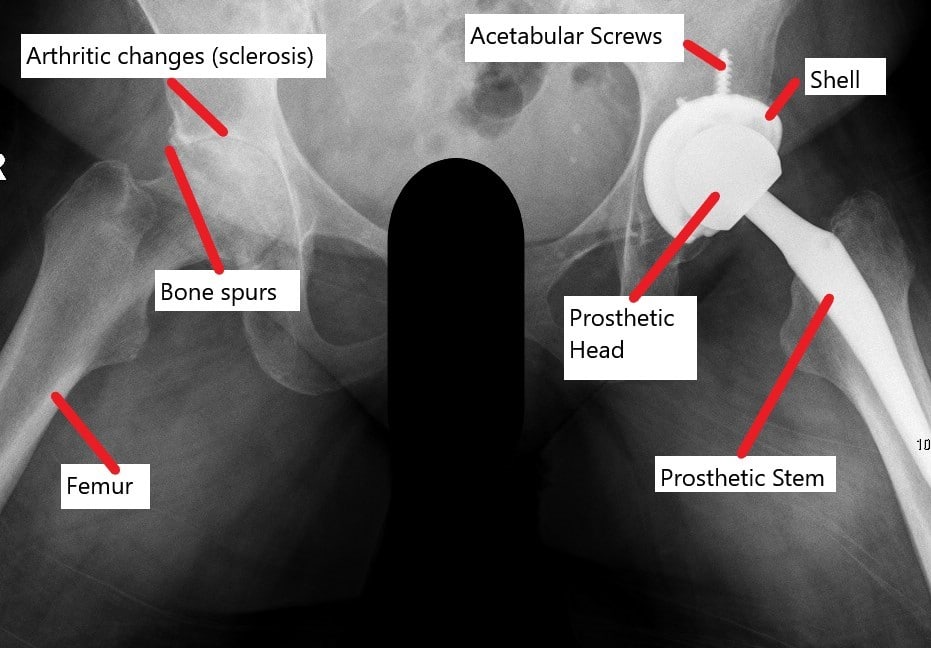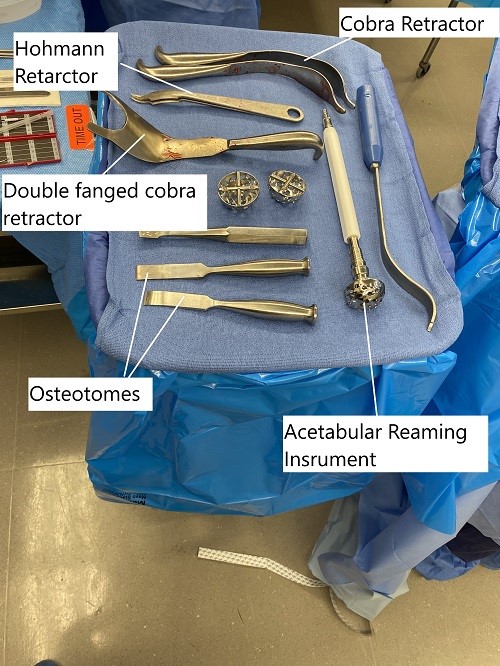Swelling after Hip Replacement
Hip or Leg swelling after hip replacement surgery is a natural response of the body to the trauma endured by the tissues during the surgery. Normally the swelling would decrease over a period of days, weeks, or even months.
However, excessive swelling after hip replacement may also be a sign of infection or deep vein thrombosis. The treating surgeon usually prescribes medications after the surgery to prevent infection and deep vein thrombosis.
During a hip replacement surgery, the surgeon removes the diseased head of the femur (thigh bone) along with the arthritic bone in the acetabulum (hip joint socket). The removed head of the femur is replaced with a prosthetic stem and head made of metal parts. A prosthetic metallic shell is placed in the acetabulum and a high-grade plastic liner is placed inside the shell.

X-ray showing a total hip replacement with a contralateral arthritic joint.
The incision of the skin and various tissues to reach the joint is closed in layers after the surgery. The body sends in thousands of cells to heal the incisions and the tissues cut/separated during the surgery known as inflammation.
The influx of these cells also brings in the fluid that builds up in the tissues causing swelling. The swelling is especially prominent in the leg due to the effect of gravity. The swelling is gradually drained by the veins in the body that transport the blood from the tissues back to the heart.
The swelling may also be controlled by measures such as icing, leg elevation, and the use of compression stockings. Icing may be done using an ice pack which is applied over the hip for a few minutes until the area becomes numb. The cold temperature soothes the nerve ends to help reduce pain.
The cold temperature also leads to narrowing of the blood vessels that bring in the excess fluid. The narrowing (constriction) of the blood vessels leads to a reduction in swelling.
The elevation of the leg also helps in the reduction of swelling after surgery. The patients are advised to raise the legs just above the heart level to help drainage of the excess fluid from the legs back to the body. The patients are often advised to lie down with their legs raised later in the evening, and at night.
Compression stockings help in getting the fluid back to the body by tightening the tissues. Similarly, the patients are advised regular exercises such as ankle pumps to reduce swelling. Contraction of the calf muscles and quadricep muscles during rehabilitation exercises helps in better circulation of the collected fluid.
Normally the swelling after surgery slowly decreases but at times, the swelling may be a sign of serious complications such as infection or deep vein thrombosis. The swelling associated with infection may occur immediately after the surgery or may occur weeks, months, or years after the surgery.
The swelling is usually associated with redness, pain and at times discharge from the operative site. The patients may complain of pain on ambulation and may report fever.
The swelling in the case of prosthetic joint infection is a result of inflammation and the debris produced by the infectious agent. The management of prosthetic joint infection is usually surgical and a staged surgery may be necessary. The surgeon usually performs a series of blood tests and a joint aspiration to determine the infectious agent.
The swelling may also occur as a result of deep vein thrombosis. Deep vein thrombosis is the formation of a blood clot in the veins of the legs. The veins carry the deoxygenated blood back to the heart that pumps the blood to the lungs for it to be re-oxygenated. The blood clot may potentially dislodge from the deep veins and travel up to the lung to cause a condition known as pulmonary embolism.
Pulmonary embolism may cause difficult breathing along with a rapid heart rate and breathing. The condition may be potentially fatal unless treated. Major surgery such as hip replacement, prolonged bed rest/travel are risk factors for deep vein thrombosis. During the incision of the tissues, certain chemicals and factors are released by the body that may facilitate the formation of blood clots.

Instruments used in total hip replacement.
The leg swelling from deep vein thrombosis occurs as a result of a blockage to the blood flow in the veins and build-up of backpressure. The increased pressure may lead to a decrease in the amount of nutrition that reaches the tissue in the legs. The reduction in nutrition may lead to cell death and subsequent inflammation that may further increase the swelling.
The surgeon usually prescribes blood-thinning medications such as aspirin or heparin after the surgery to decrease the risk of deep vein thrombosis. TED compression socks and exercises such as ankle pumps are also advised to prevent the incidence of deep vein thrombosis.
Hip replacement surgery is a highly successful surgery and some amount of pain and swelling is normal after the surgery that may subside gradually. However, patients and physicians should be vigilant of any signs of swelling that may point towards dreaded complications such as infection and deep vein thrombosis.
Do you have more questions?
Is swelling after hip replacement surgery normal, or could it indicate a complication?
Swelling is a normal part of the healing process after hip replacement surgery. However, if swelling is excessive, accompanied by severe pain or other concerning symptoms, it could indicate a complication such as infection or deep vein thrombosis.
How can I differentiate between normal postoperative swelling and signs of infection or other complications?
Signs of infection or other complications include redness, warmth, increased pain, fever, and drainage from the incision site. If you experience these symptoms, it’s important to contact your surgeon promptly.
What can I do to reduce swelling after hip replacement surgery?
Elevating the leg, applying ice packs, wearing compression stockings, staying hydrated, and performing gentle exercises as recommended by your surgeon or physical therapist can help reduce swelling.
Can certain medications contribute to swelling after hip replacement surgery?
Yes, certain medications such as blood thinners or pain medications may contribute to swelling as a side effect. It’s important to discuss any concerns about medication side effects with your healthcare provider.
How does swelling affect the recovery process after hip replacement surgery?
Swelling can temporarily limit mobility and increase discomfort during the early stages of recovery. However, as swelling decreases, mobility and comfort typically improve.
: Are there specific factors that can increase the risk of swelling after hip replacement surgery?
Factors such as obesity, pre-existing circulation problems, prolonged surgery, and certain medical conditions may increase the risk of swelling after hip replacement surgery.
Can swelling after hip replacement surgery affect the success of the procedure or the longevity of the implant?
While swelling itself is unlikely to affect the success of the procedure or the longevity of the implant, persistent or excessive swelling may warrant further evaluation to rule out underlying issues that could impact outcomes.
How does swelling after hip replacement surgery impact the range of motion and function of the hip joint?
Initially, swelling may limit the range of motion and function of the hip joint. However, as swelling decreases and rehabilitation progresses, range of motion and function typically improve.
Is it normal for swelling to fluctuate or worsen at certain times during the recovery process?
Yes, swelling may fluctuate or worsen at times, particularly after periods of increased activity or when the leg is dependent for prolonged periods. This is normal and usually resolves with rest and elevation.
Can dietary factors influence swelling after hip replacement surgery?
Maintaining a balanced diet and staying hydrated can help reduce swelling after hip replacement surgery. Avoiding excessive salt intake may also help minimize fluid retention.
Are there any warning signs associated with swelling after hip replacement surgery that require immediate medical attention?
Warning signs that require immediate medical attention include sudden or severe swelling, increasing redness or warmth around the incision site, fever, and difficulty breathing.
How does swelling after hip replacement surgery impact the fit and comfort of clothing and footwear?
Swelling may temporarily affect the fit and comfort of clothing and footwear, particularly around the hip and thigh area. Wearing loose-fitting clothing and supportive footwear can help alleviate discomfort.
Can elevation of the leg help reduce swelling after hip replacement surgery, and if so, how often and for how long should it be done?
Yes, elevating the leg above heart level can help reduce swelling after hip replacement surgery. It’s generally recommended to elevate the leg for several times a day for about 20-30 minutes each session, as tolerated.
How does the presence of swelling impact the assessment of surgical incisions and monitoring for signs of infection?
Swelling can make it more challenging to assess surgical incisions and monitor for signs of infection, such as redness or drainage. However, careful inspection and regular wound care are still important.
Can swelling after hip replacement surgery affect sleep patterns or overall comfort during rest?
Yes, swelling may cause discomfort and difficulty finding a comfortable sleeping position, particularly in the early stages of recovery. Using pillows to elevate the leg and support the hip can help improve comfort.
Can the application of heat therapy help reduce swelling after hip replacement surgery, or is cold therapy preferred?
Cold therapy is typically preferred in the early stages after hip replacement surgery to reduce swelling and inflammation. Heat therapy may be used later in the recovery process to promote relaxation and muscle flexibility.
How does the use of compression garments or wraps affect swelling after hip replacement surgery?
Compression garments or wraps can help reduce swelling by providing gentle pressure to the affected area, promoting fluid drainage, and supporting the surrounding tissues. However, it’s important to ensure that compression is applied correctly to avoid restricting blood flow.
Can massage therapy or lymphatic drainage techniques help reduce swelling after hip replacement surgery?
Yes, gentle massage therapy or lymphatic drainage techniques performed by a trained professional may help reduce swelling and improve circulation in the affected area. However, it’s important to consult with your healthcare provider before starting any new therapies.
How does the timing and intensity of physical activity or rehabilitation exercises impact swelling after hip replacement surgery?
Gradually increasing the intensity and duration of physical activity and rehabilitation exercises as tolerated can help minimize swelling and promote healing after hip replacement surgery. However, overexertion or excessive activity may exacerbate swelling and delay recovery.

Dr. Suhirad Khokhar
My name is Dr. Suhirad Khokhar, and am an orthopaedic surgeon. I completed my MBBS (Bachelor of Medicine & Bachelor of Surgery) at Govt. Medical College, Patiala, India.
I specialize in musculoskeletal disorders and their management, and have personally approved of and written this content.
My profile page has all of my educational information, work experience, and all the pages on this site that I've contributed to.
